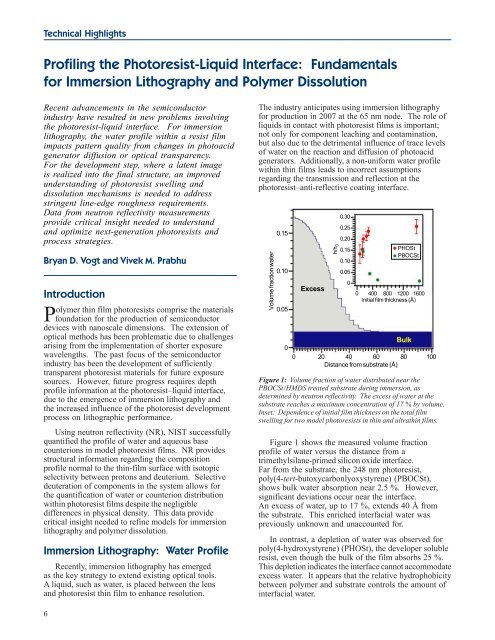Materials Science and Engineering Laboratory FY 2004 ... - NIST
Materials Science and Engineering Laboratory FY 2004 ... - NIST
Materials Science and Engineering Laboratory FY 2004 ... - NIST
Create successful ePaper yourself
Turn your PDF publications into a flip-book with our unique Google optimized e-Paper software.
Technical Highlights<br />
Profiling the Photoresist-Liquid Interface: Fundamentals<br />
for Immersion Lithography <strong>and</strong> Polymer Dissolution<br />
Recent advancements in the semiconductor<br />
industry have resulted in new problems involving<br />
the photoresist-liquid interface. For immersion<br />
lithography, the water profile within a resist film<br />
impacts pattern quality from changes in photoacid<br />
generator diffusion or optical transparency.<br />
For the development step, where a latent image<br />
is realized into the final structure, an improved<br />
underst<strong>and</strong>ing of photoresist swelling <strong>and</strong><br />
dissolution mechanisms is needed to address<br />
stringent line-edge roughness requirements.<br />
Data from neutron reflectivity measurements<br />
provide critical insight needed to underst<strong>and</strong><br />
<strong>and</strong> optimize next-generation photoresists <strong>and</strong><br />
process strategies.<br />
Bryan D. Vogt <strong>and</strong> Vivek M. Prabhu<br />
Introduction<br />
Polymer thin film photoresists comprise the materials<br />
foundation for the production of semiconductor<br />
devices with nanoscale dimensions. The extension of<br />
optical methods has been problematic due to challenges<br />
arising from the implementation of shorter exposure<br />
wavelengths. The past focus of the semiconductor<br />
industry has been the development of sufficiently<br />
transparent photoresist materials for future exposure<br />
sources. However, future progress requires depth<br />
profile information at the photoresist–liquid interface,<br />
due to the emergence of immersion lithography <strong>and</strong><br />
the increased influence of the photoresist development<br />
process on lithographic performance.<br />
Using neutron reflectivity (NR), <strong>NIST</strong> successfully<br />
quantified the profile of water <strong>and</strong> aqueous base<br />
counterions in model photoresist films. NR provides<br />
structural information regarding the composition<br />
profile normal to the thin-film surface with isotopic<br />
selectivity between protons <strong>and</strong> deuterium. Selective<br />
deuteration of components in the system allows for<br />
the quantification of water or counterion distribution<br />
within photoresist films despite the negligible<br />
differences in physical density. This data provide<br />
critical insight needed to refine models for immersion<br />
lithography <strong>and</strong> polymer dissolution.<br />
Immersion Lithography: Water Profile<br />
Recently, immersion lithography has emerged<br />
as the key strategy to extend existing optical tools.<br />
A liquid, such as water, is placed between the lens<br />
<strong>and</strong> photoresist thin film to enhance resolution.<br />
6<br />
The industry anticipates using immersion lithography<br />
for production in 2007 at the 65 nm node. The role of<br />
liquids in contact with photoresist films is important;<br />
not only for component leaching <strong>and</strong> contamination,<br />
but also due to the detrimental influence of trace levels<br />
of water on the reaction <strong>and</strong> diffusion of photoacid<br />
generators. Additionally, a non-uniform water profile<br />
within thin films leads to incorrect assumptions<br />
regarding the transmission <strong>and</strong> reflection at the<br />
photoresist–anti-reflective coating interface.<br />
Figure 1: Volume fraction of water distributed near the<br />
PBOCSt/HMDS treated substrate during immersion, as<br />
determined by neutron reflectivity. The excess of water at the<br />
substrate reaches a maximum concentration of 17 % by volume.<br />
Inset: Dependence of initial film thickness on the total film<br />
swelling for two model photoresists in thin <strong>and</strong> ultrathin films.<br />
Figure 1 shows the measured volume fraction<br />
profile of water versus the distance from a<br />
trimethylsilane-primed silicon oxide interface.<br />
Far from the substrate, the 248 nm photoresist,<br />
poly(4-tert-butoxycarbonlyoxystyrene) (PBOCSt),<br />
shows bulk water absorption near 2.5 %. However,<br />
significant deviations occur near the interface.<br />
An excess of water, up to 17 %, extends 40 Å from<br />
the substrate. This enriched interfacial water was<br />
previously unknown <strong>and</strong> unaccounted for.<br />
In contrast, a depletion of water was observed for<br />
poly(4-hydroxystyrene) (PHOSt), the developer soluble<br />
resist, even though the bulk of the film absorbs 25 %.<br />
This depletion indicates the interface cannot accommodate<br />
excess water. It appears that the relative hydrophobicity<br />
between polymer <strong>and</strong> substrate controls the amount of<br />
interfacial water.

















